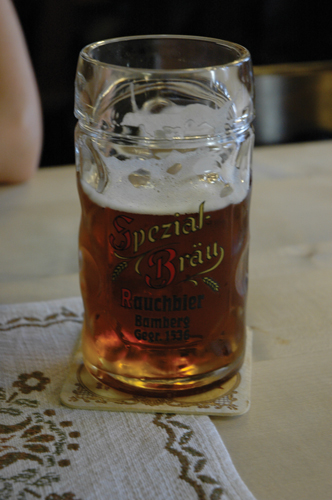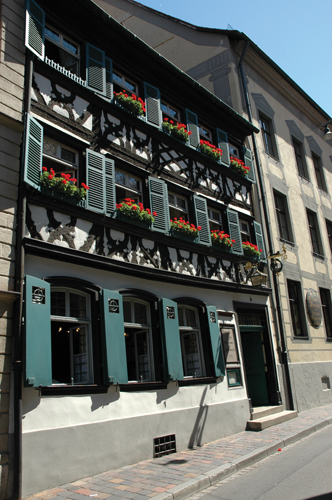
ラオホビールは、ドイツ・バイエルン州のバンベルク周辺で発祥したラガーもしくは小麦を使ったエールのスタイルである。スモーキーな香りと味わいのため、非常に個性的かつ印象的なビールだ。その香りと味わいは煙を用いて直接乾燥されたモルトに由来する。
ビールをつくる際、大麦は必ず麦芽にする。地中に植えたときと同じ効果が出るよう、芽を出させるために大麦を水に浸すのだ。この発芽により、種子の中にあるデンプンを糖に変える酵素が生まれる。そうしてできた麦芽は、新しい苗にまで育たないように、乾燥させなければならない。今日ではこの乾燥の際、間接的な熱を用いる。しかしラオホ麦芽は、薪の直火で乾燥される。これにより、薪から立ち上がった煙は麦芽の中を通り過ぎ、麦芽に煙の味わいを加えてくれる。18世紀まではほとんどすべてのビールには、直火で乾燥させた麦芽がいくらかは含まれていた。間接的な焙燥の技術がまだ実用化されていなかったからである。しかし今日では燻製した麦芽は、木や煙の味わいを付け加える目的で使われる。
こうして、いぶした麦芽はポーターやスタウト、そしてもっとライトなエールと、様々な種類のビールに用いられる。しかし一度廃れたが復活したスタイルとは対照的に、バイエルンのラオホビアが唯一の、継続して存在している燻製ビールのスタイルなのだ。その証拠に、熟成したブナの丸太を薪にした火でつくった燻製麦芽を使うことを、バイエルンの醸造家たちは完全には捨て去っていない。
ラオホスタイルのビールは、普通はビールを連想させないベーコンや木、スモークサーモンの香りがして、ビール初心者をしばしば驚かせる。銘柄ごとにいぶした感じの程度は様々だが、味わいは似通っている。あるラオホスタイルの銘柄ではいぶした感じがほんの少し感じられる程度なのに、ほかの銘柄では燻製にしたベーコンのような味がずっとすることがある。しかしながらラオホスタイルのビールは、スタウトのような焦げた、もしくは炒った感じの味がしないほうがいい。
最も伝統的なラオホビールは下面発酵のメルツェンであり、深い琥珀色から中程度の茶色にかけた色をしている。一方で、へレス、ボック、ヴァイツェンをベースにしたラオホビールもよく見かける。ラオホヴァイツェンはバナナとクローヴ(丁子)の香りが燻製の香りとかなり不安定に交じりあって、特に興味深いだろう。すべてのラオホビールではホップは軽めに使われ、ホップの香りもほとんど感じられないようにつくられる傾向にある。
ラオホビールのなかでも最高水準にあるものは、バンベルクのシュレンケルラ醸造所のものである。彼らのメルツェン、ウアボック、ヴァイツェン、アイヒェドッペルボックはフルボディーで、豊かな麦芽風味とたっぷりとした燻製香を持つ甘美なビールである。これらは日本でもかなり簡単に見つけられる。バンベルクにはほかにも素晴らしいラオホビールがあり、ラオホビールが好きなった人は、それらを味わうためにバンベルクを訪れなければならなくなる。しかしながら私は、最高のラオホビールはバイエルンではなく日本でつくられていると思っている。田沢湖ビールと富士桜高原ビールのラオホビールは、バンベルクでつくられるものと比べると強烈な燻製香が弱いが、世界レベルの本物である。富士桜高原ビールは過去にラオホボックとラオホヴァイツェンもつくっていて、再び味わえるのが待ちきれない。そのほか納得のいくラオホビールは、門司港地ビール、ベアレン、エチゴビール、オークラブラッスリー、御殿場高原ビールでつくられている。日本の醸造家は燻製を味わう良い味覚を持っているようだ!
食べ物との相性も優れている。伝統的な組み合わせはバイエルン風ソーセージまたはローストポークであろうし、それに勝るものはなかなかない。しかしウナギ(の蒲焼)や焼き鳥、そしてカツオのたたきといった焼いた和食の味も補ってくれる。私のいる京都で、おいしいぼたん鍋(野生のイノシシの味噌鍋)と一緒にラオホビールを楽しめたらどんなにいいかと思っている。バンベルクの人々は一年中ラオホビールを飲んでいて、できるなら私もそうしたい。しかしこのビールは日本の冬に自然に合うようにも思える。

All Beer Styles articles are written by Mark Meli, author of Craft Beer in Japan.
This article was published in Japan Beer Times # () and is among the limited content available online. Order your copy through our online shop or download the digital version from the iTunes store to access the full contents of this issue.


